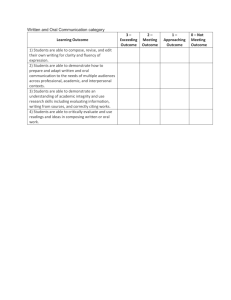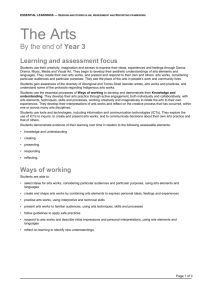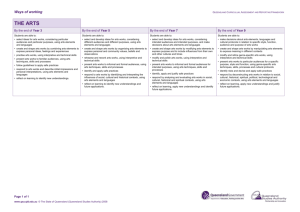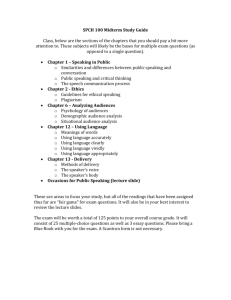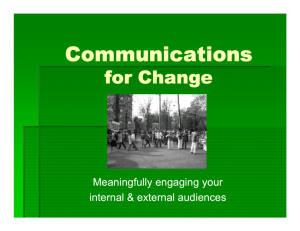The Arts: Essential Learnings by the end of Year 7
advertisement
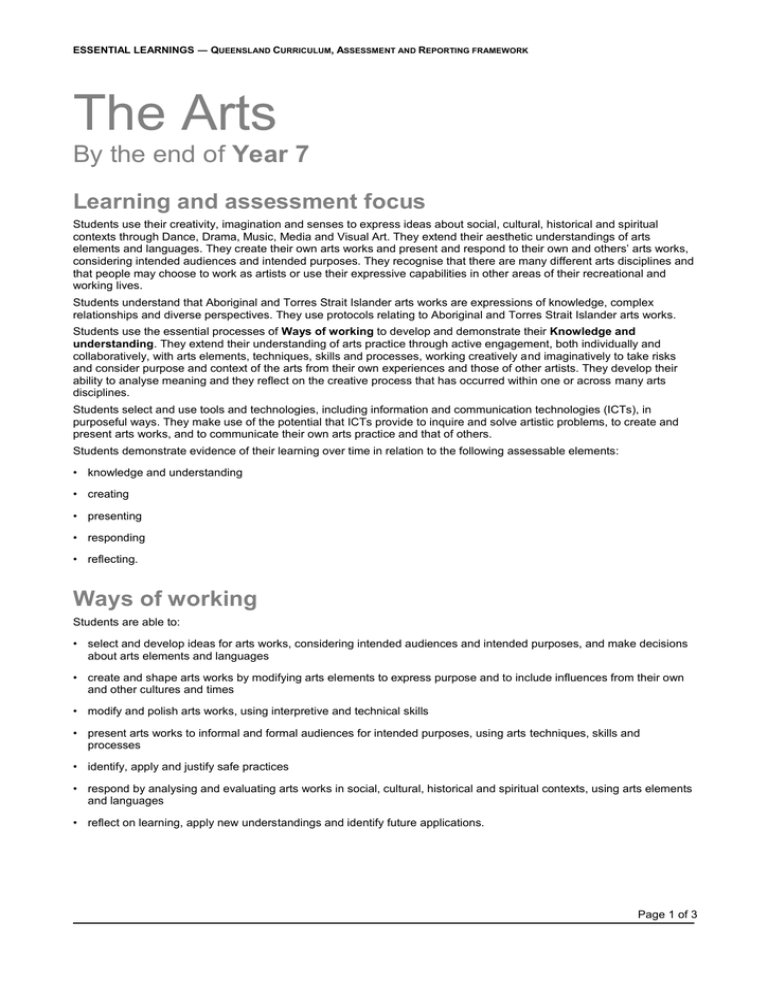
ESSENTIAL LEARNINGS ― QUEENSLAND CURRICULUM, ASSESSMENT AND REPORTING FRAMEWORK The Arts By the end of Year 7 Learning and assessment focus Students use their creativity, imagination and senses to express ideas about social, cultural, historical and spiritual contexts through Dance, Drama, Music, Media and Visual Art. They extend their aesthetic understandings of arts elements and languages. They create their own arts works and present and respond to their own and others’ arts works, considering intended audiences and intended purposes. They recognise that there are many different arts disciplines and that people may choose to work as artists or use their expressive capabilities in other areas of their recreational and working lives. Students understand that Aboriginal and Torres Strait Islander arts works are expressions of knowledge, complex relationships and diverse perspectives. They use protocols relating to Aboriginal and Torres Strait Islander arts works. Students use the essential processes of Ways of working to develop and demonstrate their Knowledge and understanding. They extend their understanding of arts practice through active engagement, both individually and collaboratively, with arts elements, techniques, skills and processes, working creatively and imaginatively to take risks and consider purpose and context of the arts from their own experiences and those of other artists. They develop their ability to analyse meaning and they reflect on the creative process that has occurred within one or across many arts disciplines. Students select and use tools and technologies, including information and communication technologies (ICTs), in purposeful ways. They make use of the potential that ICTs provide to inquire and solve artistic problems, to create and present arts works, and to communicate their own arts practice and that of others. Students demonstrate evidence of their learning over time in relation to the following assessable elements: • knowledge and understanding • creating • presenting • responding • reflecting. Ways of working Students are able to: • select and develop ideas for arts works, considering intended audiences and intended purposes, and make decisions about arts elements and languages • create and shape arts works by modifying arts elements to express purpose and to include influences from their own and other cultures and times • modify and polish arts works, using interpretive and technical skills • present arts works to informal and formal audiences for intended purposes, using arts techniques, skills and processes • identify, apply and justify safe practices • respond by analysing and evaluating arts works in social, cultural, historical and spiritual contexts, using arts elements and languages • reflect on learning, apply new understandings and identify future applications. Page 1 of 3 ESSENTIAL LEARNINGS ― QUEENSLAND CURRICULUM, ASSESSMENT AND REPORTING FRAMEWORK Knowledge and understanding Dance Dance involves using the human body to express ideas, considering intended audiences and intended purposes, by modifying dance elements in movement sequences. • Combinations of locomotor and non-locomotor movements are used to create actions for movement sequences e.g. combining leaping, extending arms and dropping to the ground. • Directional focus is used to draw attention in space in movement sequences e.g. extending arms to stage right to draw the audience’s attention to a focus. • Combinations of simple and compound time signatures are used to modify timing of movements in sequences e.g. moving to mixture of and time signatures. • Suspending and vibrating movement qualities are used to modify energy e.g. using quick pulsating movements to represent a racing heartbeat; using slow floating movements to represent the land. • Structuring devices, including transitions, motifs and improvisation forms, are used to organise movement sequences e.g. representing anger with a recurrent theme or pattern (motif) of strong fists. Drama Drama involves modifying dramatic elements and conventions to express ideas, considering intended audiences and intended purposes, through dramatic action based on real or imagined events. • Roles and characters can be presented from different perspectives and in different situations, using variations in voice, movement and focus e.g. presenting land-user, traditional owner, environmentalist and government representative roles in an environmental issues drama. • Purpose and context are considered when modifying mood, time frames, language, place and space, and are used to express ideas e.g. changing mood of tired and depressed shipwreck survivors when a rescue boat is sighted. • Dramatic action is interpreted, prepared and shaped through scenarios and scripts e.g. using a student-devised script on a school-based issue such as bullying. Media Media involves constructing meaning, considering intended audiences and intended purposes, by modifying media languages and technologies to create representations. • Still and moving images, sounds and words are applied and modified, using genre conventions, to construct media texts e.g. using conventions such as studio interviews, narration, commentary and dramatic re-enactment in a radio, video or web-based documentary on Australian Indigenous land rights. • Media techniques and practices, including editing and publishing, are used to create media texts e.g. using digital editing techniques to produce a DVD. • Representations in media texts have specific purposes and are modified to maximise audience impact e.g. using eye-catching images, slogans and jingles for a marketing campaign for a new product to target a teenage audience; using appropriate media images of Aboriginal peoples in a promotional video for a local context. Page 2 of 3 ESSENTIAL LEARNINGS ― QUEENSLAND CURRICULUM, ASSESSMENT AND REPORTING FRAMEWORK Music Music involves singing, playing instruments, listening, moving, improvising and composing by modifying the music elements to express ideas, considering intended audiences and intended purposes, through sound. • Duration, beat, time values and metre are used to create rhythm e.g. playing a polyrhythm within a small ensemble. • Pitch and intervals are used to create melody e.g. composing a short melody over a tonic and dominant chord progression. • Tonalities and harmonies are used to organise music in vertical arrangements e.g. playing major/minor keys, chord progressions and riffs. • Contemporary and traditional musical forms are used to structure music e.g. playing music in strophic form; composing a 12-bar blues song; identifying repetitive singing in vocal sequences of Aboriginal music and songs. • Vocal, instrumental and electronic sound sources have characteristic sound qualities (tone colour) e.g. hearing and identifying orchestral timbres. • Relative softness and loudness and emphasis of sounds are used to change dynamic levels and expression of music e.g. using accents to emphasise particular beats of a song. Visual Art Visual Art involves modifying visual arts elements, concepts, processes and forms (both 2D and 3D) to express ideas, considering intended audiences and intended purposes, through images and objects. • Blended, controlled and symbolic colour is used to create depth, representation and symbolism e.g. using mixed and blended colour to add depth in abstract paintings. • Descriptive and emotive lines are used to create abstraction, proportion and symbolism e.g. using fluid lines to show an emotional response to a stimulus. • Negative space and positive shape are used to create abstraction, non-representation and proportion e.g. using photographs of natural shapes in their environments to focus on negative spaces and positive shapes and thus show effects of light and dark. • Actual, invented and simulated textures are used to create depth, representation and non-representation e.g. using texture in a collograph print to express ideas about water without using representational imagery. Page 3 of 3
